Optimizing Task Offloading Energy in Multi-User Multi-UAV-Enabled Mobile Edge-Cloud Computing Systems
Abstract
:1. Introduction
- An energy-efficient system model for multi-user multi-UAV-enabled mobile edge-cloud computing. This system is a scalable system and can support increased network traffic without performance degradation;
- A network of UAVs is deployed to cover the dead and high-density network areas. In addition, UAVs can provide other applications over the smart city network in which the multilevel MEC technology is deployed to provide both the computational capabilities at the edge network as well as a core network based on SDN technology to manage the network traffic and provide an innovative interface to the network operators;
- A combination model of resource allocation and offloading is formulated as a problem which aims to minimize the energy consumption of the whole system with a latency constraint;
- Simulations validate our proposed model and demonstrate that the system’s energy consumption can be significantly decreased.
2. Related Work
2.1. Single Edge Server
2.2. Multiple Edge Servers
2.3. Multiple Edge Servers and Remote Cloud
3. System Model
3.1. Communication Model
3.2. Computation Model
3.2.1. Local Execution
3.2.2. Remote Execution
3.3. Problem Formulation
3.4. A Multi-Tier Energy-Efficient Task Offloading Algorithm
| Algorithm 1 Multi-tier energy-efficient computation offloading algorithm. |
|
4. Simulation Results and Discussion
4.1. Experimental Setup
4.2. Experimental Results & Discussion
- Local Execution: No offloading exists. The computation tasks of all mobile devices will be processed locally ;
- UAVs Server Execution: The computation tasks of all mobile devices will be processed remotely at UAVs servers ;
- Cloud Execution: The computation tasks of all mobile devices will be processed remotely at the cloud server ;
5. Conclusions
Author Contributions
Funding
Institutional Review Board Statement
Informed Consent Statement
Acknowledgments
Conflicts of Interest
References
- Wang, J.; Jiang, C.; Han, Z.; Ren, Y.; Maunder, R.G.; Hanzo, L. Taking drones to the next level: Cooperative distributed unmanned-aerial-vehicular networks for small and mini drones. IEEE Veh. Technol. Mag. 2017, 12, 73–82. [Google Scholar] [CrossRef] [Green Version]
- CAAC. Low-Altitude Connected Drone Flight Safety Test Report. Available online: http://www.caac.gov.cn/en/ (accessed on 27 April 2022).
- Hayat, S.; Yanmaz, E.; Muzaffar, R. Survey on unmanned aerial vehicle networks for civil applications: A communications viewpoint. IEEE Commun. Surv. Tutorials 2016, 18, 2624–2661. [Google Scholar] [CrossRef]
- Zeng, Y.; Zhang, R.; Lim, T.J. Wireless communications with unmanned aerial vehicles: Opportunities and challenges. IEEE Commun. Mag. 2016, 54, 36–42. [Google Scholar] [CrossRef] [Green Version]
- Yaacoub, E.; Alouini, M.S. A key 6G challenge and opportunity—connecting the base of the pyramid: A survey on rural connectivity. Proc. IEEE 2020, 108, 533–582. [Google Scholar] [CrossRef] [Green Version]
- Dang, S.; Amin, O.; Shihada, B.; Alouini, M.S. What should 6G be? Nat. Electron. 2020, 3, 20–29. [Google Scholar] [CrossRef] [Green Version]
- Tikhomirov, A.; Omelyanchuk, E.; Semenova, A. Recommended 5G frequency bands evaluation. In Proceedings of the 2018 Systems of Signals Generating and Processing in the Field of on Board Communications, Moscow, Russia, 14–15 March 2018; pp. 1–5. [Google Scholar]
- Bargis, M.; Romano, G. From Standards to Service-the European Way to 5G. IEEE 5G Tech Focus 2017, 1, 15–21. [Google Scholar]
- Obanawa, H.; Shibata, H. Applications of UAV Remote Sensing to Topographic and Vegetation Surveys. In Unmanned Aerial Vehicle: Applications in Agriculture and Environment; Springer: Berlin/Heidelberg, Germany, 2020; pp. 131–142. [Google Scholar]
- Bithas, P.S.; Michailidis, E.T.; Nomikos, N.; Vouyioukas, D.; Kanatas, A.G. A Survey on Machine-Learning Techniques for UAV-Based Communications. Sensors 2019, 19, 5170. [Google Scholar] [CrossRef] [Green Version]
- Khayyat, M.; Alshahrani, A.; Alharbi, S.; Elgendy, I.; Paramonov, A.; Koucheryavy, A. Multilevel Service-Provisioning-Based Autonomous Vehicle Applications. Sustainability 2020, 12, 2497. [Google Scholar] [CrossRef] [Green Version]
- Mach, P.; Becvar, Z. Mobile edge computing: A survey on architecture and computation offloading. IEEE Commun. Surv. Tutorials 2017, 19, 1628–1656. [Google Scholar] [CrossRef] [Green Version]
- Cheng, N.; Xu, W.; Shi, W.; Zhou, Y.; Lu, N.; Zhou, H.; Shen, X. Air-ground integrated mobile edge networks: Architecture, challenges, and opportunities. IEEE Commun. Mag. 2018, 56, 26–32. [Google Scholar] [CrossRef] [Green Version]
- Zhou, F.; Wu, Y.; Hu, R.Q.; Qian, Y. Computation rate maximization in UAV-enabled wireless-powered mobile-edge computing systems. IEEE J. Sel. Areas Commun. 2018, 36, 1927–1941. [Google Scholar] [CrossRef] [Green Version]
- Mao, Y.; You, C.; Zhang, J.; Huang, K.; Letaief, K.B. A survey on mobile edge computing: The communication perspective. IEEE Commun. Surv. Tutorials 2017, 19, 2322–2358. [Google Scholar] [CrossRef] [Green Version]
- Khayyat, M.; Elgendy, I.A.; Muthanna, A.; Alshahrani, A.; Alharbi, S.; Koucheryavy, A. Advanced Deep Learning-based Computational Offloading for Multilevel Vehicular Edge-Cloud Computing Networks. IEEE Access 2020, 8, 137052–137062. [Google Scholar] [CrossRef]
- Zhang, X.; Zhong, Y.; Liu, P.; Zhou, F.; Wang, Y. Resource allocation for a UAV-enabled mobile-edge computing system: Computation efficiency maximization. IEEE Access 2019, 7, 113345–113354. [Google Scholar] [CrossRef]
- Zhang, J.; Zhou, L.; Tang, Q.; Ngai, E.C.H.; Hu, X.; Zhao, H.; Wei, J. Stochastic computation offloading and trajectory scheduling for UAV-assisted mobile edge computing. IEEE Internet Things J. 2018, 6, 3688–3699. [Google Scholar] [CrossRef]
- Beiqing, C.; Haihang, Z.; Jianguo, Y.; Haibing, G. RESERVE: An Energy-Efficient Edge Cloud Architecture for Intelligent Multi-UAV. IEEE Trans. Serv. Comput. 2019, 15, 819–832. [Google Scholar]
- You, C.; Huang, K.; Chae, H. Energy efficient mobile cloud computing powered by wireless energy transfer. IEEE J. Sel. Areas Commun. 2016, 34, 1757–1771. [Google Scholar] [CrossRef] [Green Version]
- Huang, L.; Bi, S.; Zhang, Y.J. Deep reinforcement learning for online computation offloading in wireless powered mobile-edge computing networks. IEEE Trans. Mob. Comput. 2019, 19, 2581–2593. [Google Scholar] [CrossRef] [Green Version]
- Wang, Y.; Sheng, M.; Wang, X.; Wang, L.; Li, J. Mobile-edge computing: Partial computation offloading using dynamic voltage scaling. IEEE Trans. Commun. 2016, 64, 4268–4282. [Google Scholar] [CrossRef]
- Dinh, T.Q.; La, Q.D.; Quek, T.Q.; Shin, H. Learning for computation offloading in mobile edge computing. IEEE Trans. Commun. 2018, 66, 6353–6367. [Google Scholar] [CrossRef]
- Liu, F.; Huang, Z.; Wang, L. Energy-efficient collaborative task computation offloading in cloud-assisted edge computing for IoT sensors. Sensors 2019, 19, 1105. [Google Scholar] [CrossRef] [PubMed] [Green Version]
- Qu, G.; Wu, H.; Li, R.; Jiao, P. DMRO: A deep meta reinforcement learning-based task offloading framework for edge-cloud computing. IEEE Trans. Netw. Serv. Manag. 2021, 18, 3448–3459. [Google Scholar] [CrossRef]
- Lu, H.; He, X.; Du, M.; Ruan, X.; Sun, Y.; Wang, K. Edge QoE: Computation offloading with deep reinforcement learning for Internet of Things. IEEE Internet Things J. 2020, 7, 9255–9265. [Google Scholar] [CrossRef]
- Ji, L.; Guo, S. Energy-efficient cooperative resource allocation in wireless powered mobile edge computing. IEEE Internet Things J. 2018, 6, 4744–4754. [Google Scholar] [CrossRef]
- Hu, L.; Tian, Y.; Yang, J.; Taleb, T.; Xiang, L.; Hao, Y. Ready player one: UAV-clustering-based multi-task offloading for vehicular VR/AR gaming. IEEE Netw. 2019, 33, 42–48. [Google Scholar] [CrossRef] [Green Version]
- Zhan, Y.; Guo, S.; Li, P.; Zhang, J. A deep reinforcement learning based offloading game in edge computing. IEEE Trans. Comput. 2020, 69, 883–893. [Google Scholar] [CrossRef]
- Wang, Y.; Chen, W.; Luan, T.H.; Su, Z.; Xu, Q.; Li, R.; Chen, N. Task Offloading for Post-Disaster Rescue in Unmanned Aerial Vehicles Networks. IEEE/ACM Trans. Netw. 2022. early access. [Google Scholar] [CrossRef]
- Zhou, Z.; Feng, J.; Tan, L.; He, Y.; Gong, J. An air-ground integration approach for mobile edge computing in IoT. IEEE Commun. Mag. 2018, 56, 40–47. [Google Scholar] [CrossRef]
- Lin, L.; Li, P.; Liao, X.; Jin, H.; Zhang, Y. Echo: An edge-centric code offloading system with quality of service guarantee. IEEE Access 2018, 7, 5905–5917. [Google Scholar] [CrossRef]
- Goudarzi, M.; Wu, H.; Palaniswami, M.; Buyya, R. An application placement technique for concurrent IoT applications in edge and fog computing environments. IEEE Trans. Mob. Comput. 2021, 20, 1298–1311. [Google Scholar] [CrossRef]
- Xia, J.; Wang, P.; Li, B.; Fei, Z. Intelligent task offloading and collaborative computation in multi-UAV-enabled mobile edge computing. China Commun. 2022, 19, 244–256. [Google Scholar] [CrossRef]
- Bai, T.; Wang, J.; Ren, Y.; Hanzo, L. Energy-Efficient Computation Offloading for Secure UAV-Edge-Computing Systems. IEEE Trans. Veh. Technol. 2019, 68, 6074–6087. [Google Scholar] [CrossRef] [Green Version]
- Yang, Z.; Pan, C.; Wang, K.; Shikh-Bahaei, M. Energy Efficient Resource Allocation in UAV-Enabled Mobile Edge Computing Networks. arXiv 2019, arXiv:1902.03158. [Google Scholar] [CrossRef]
- Elgendy, I.; Zhang, W.; Liu, C.; Hsu, C.H. An efficient and secured framework for mobile cloud computing. IEEE Trans. Cloud Comput. 2018, 9, 79–87. [Google Scholar] [CrossRef]
- Deb, S.; Monogioudis, P. Learning-based uplink interference management in 4G LTE cellular systems. IEEE/ACM Trans. Netw. 2015, 23, 398–411. [Google Scholar] [CrossRef]
- Sun, S.; Zhang, G.; Mei, H.; Wang, K.; Yang, K. Optimizing multi-UAV deployment in 3-D space to minimize task completion time in UAV-enabled mobile edge computing systems. IEEE Commun. Lett. 2021, 25, 579–583. [Google Scholar] [CrossRef]
- Elgendy, I.A.; Zhang, W.; Tian, Y.C.; Li, K. Resource allocation and computation offloading with data security for mobile edge computing. Future Gener. Comput. Syst. 2019, 100, 531–541. [Google Scholar] [CrossRef]
- Lyu, X.; Tian, H.; Sengul, C.; Zhang, P. Multiuser joint task offloading and resource optimization in proximate clouds. IEEE Trans. Veh. Technol. 2016, 66, 3435–3447. [Google Scholar] [CrossRef]
- Elgendy, I.A.; Zhang, W.Z.; Zeng, Y.; He, H.; Tian, Y.C.; Yang, Y. Efficient and Secure Multi-User Multi-Task Computation Offloading for Mobile-Edge Computing in Mobile IoT Networks. IEEE Trans. Netw. Serv. Manag. 2020, 17, 2410–2422. [Google Scholar] [CrossRef]
- Lyu, X.; Tian, H. Adaptive receding horizon offloading strategy under dynamic environment. IEEE Commun. Lett. 2016, 20, 878–881. [Google Scholar] [CrossRef]
- Chen, X. Decentralized Computation Offloading Game for Mobile Cloud Computing. IEEE Trans. Parallel Distrib. Syst. 2015, 26, 974–983. [Google Scholar] [CrossRef] [Green Version]
- Fooladivanda, D.; Rosenberg, C. Joint resource allocation and user association for heterogeneous wireless cellular networks. IEEE Trans. Wirel. Commun. 2012, 12, 248–257. [Google Scholar] [CrossRef]
- Guignard, M. Lagrangean relaxation. Top 2003, 11, 151–200. [Google Scholar] [CrossRef]
- Chen, X.; Jiao, L.; Li, W.; Fu, X. Efficient multi-user computation offloading for mobile-edge cloud computing. IEEE/ACM Trans. Netw. 2015, 24, 2795–2808. [Google Scholar] [CrossRef] [Green Version]
- Beal, L.D.; Hill, D.C.; Martin, R.A.; Hedengren, J.D. Gekko optimization suite. Processes 2018, 6, 106. [Google Scholar] [CrossRef] [Green Version]
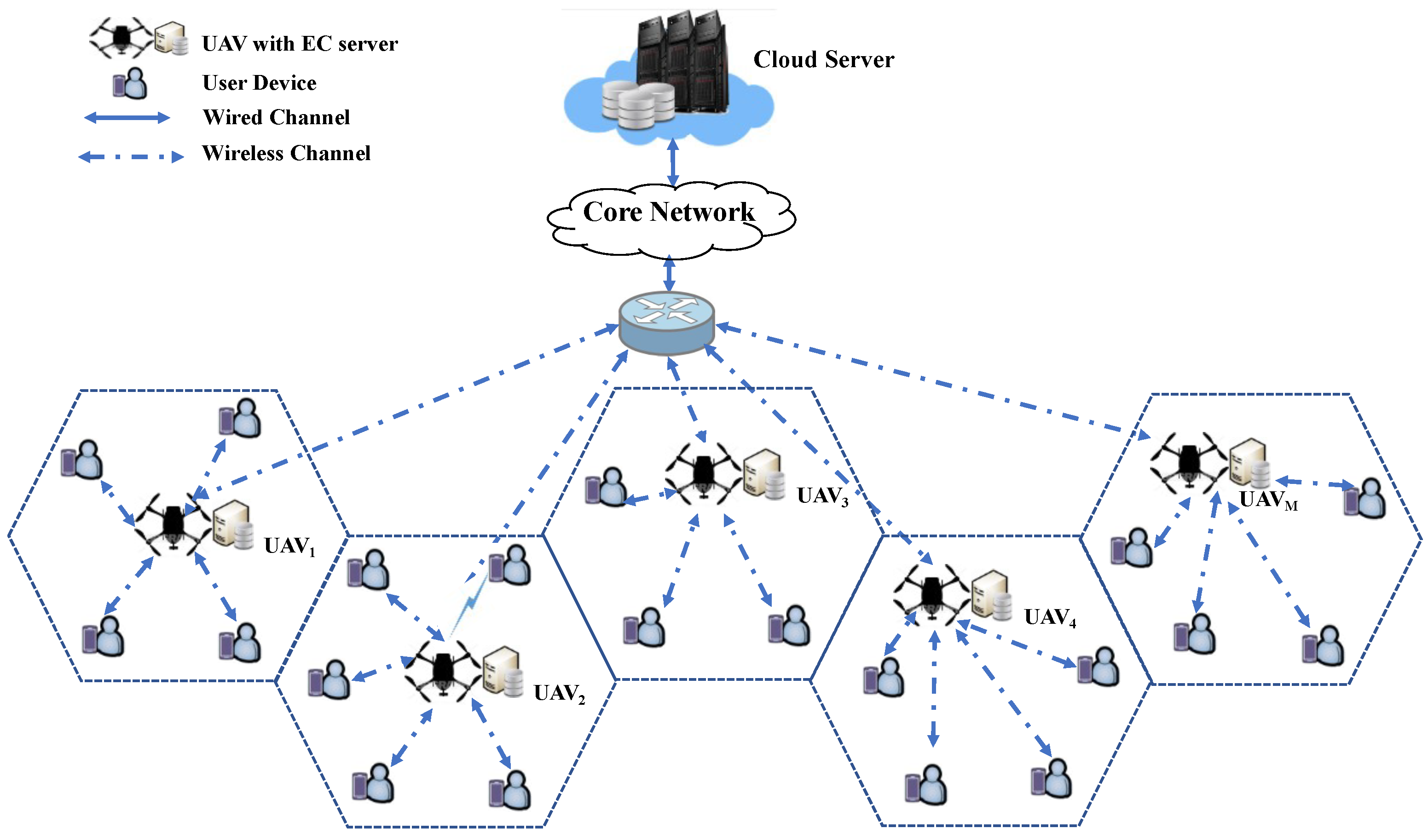

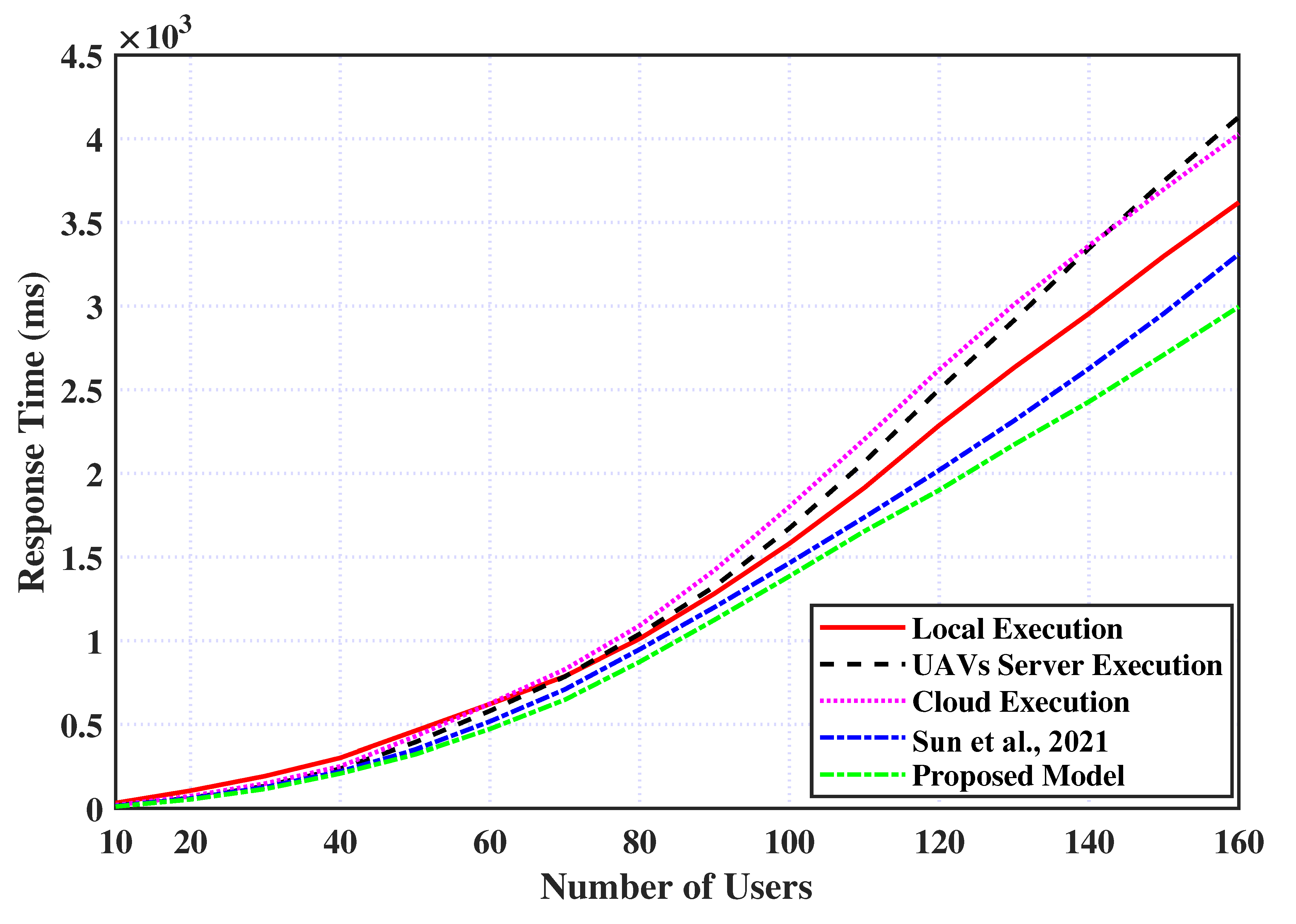
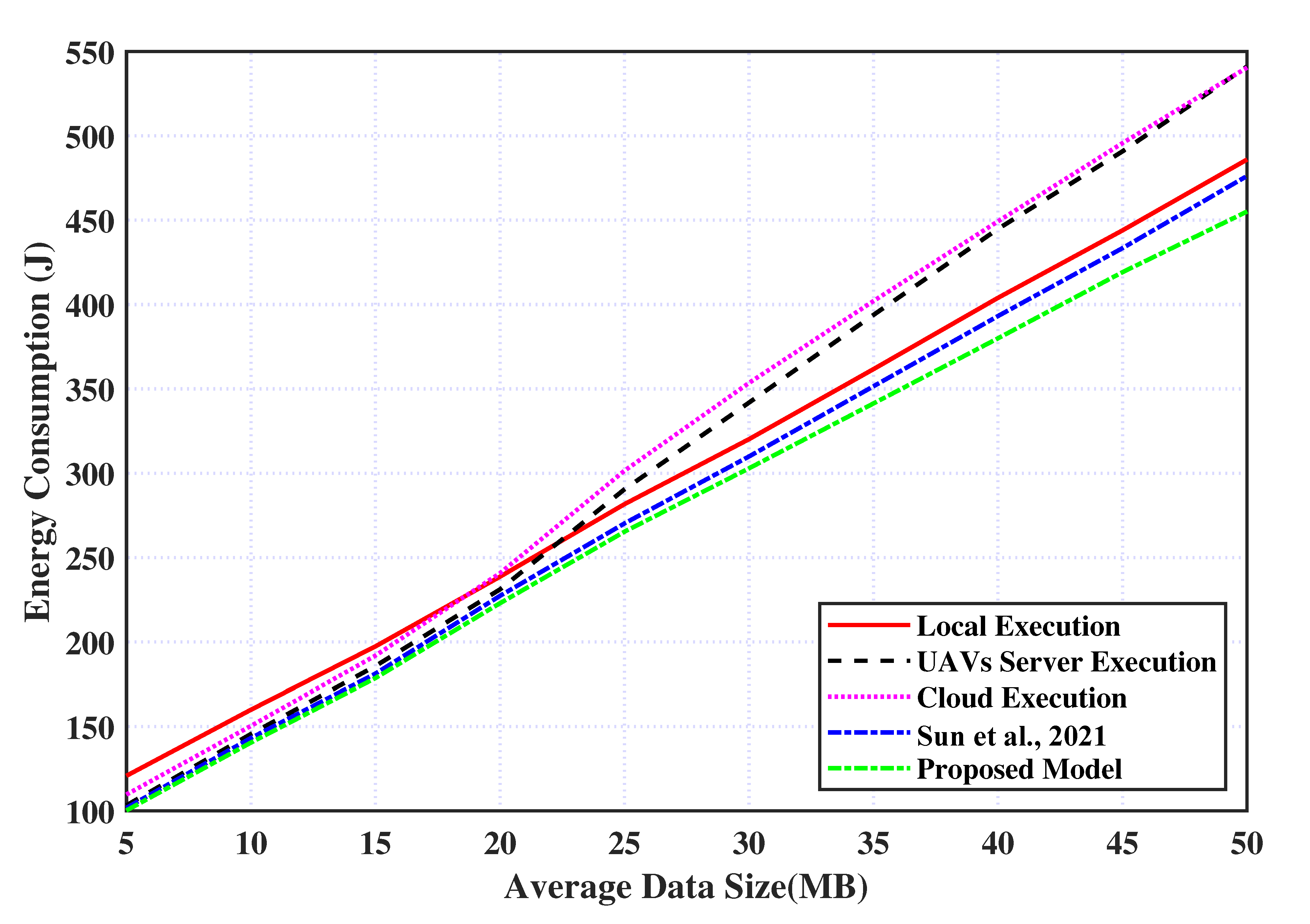
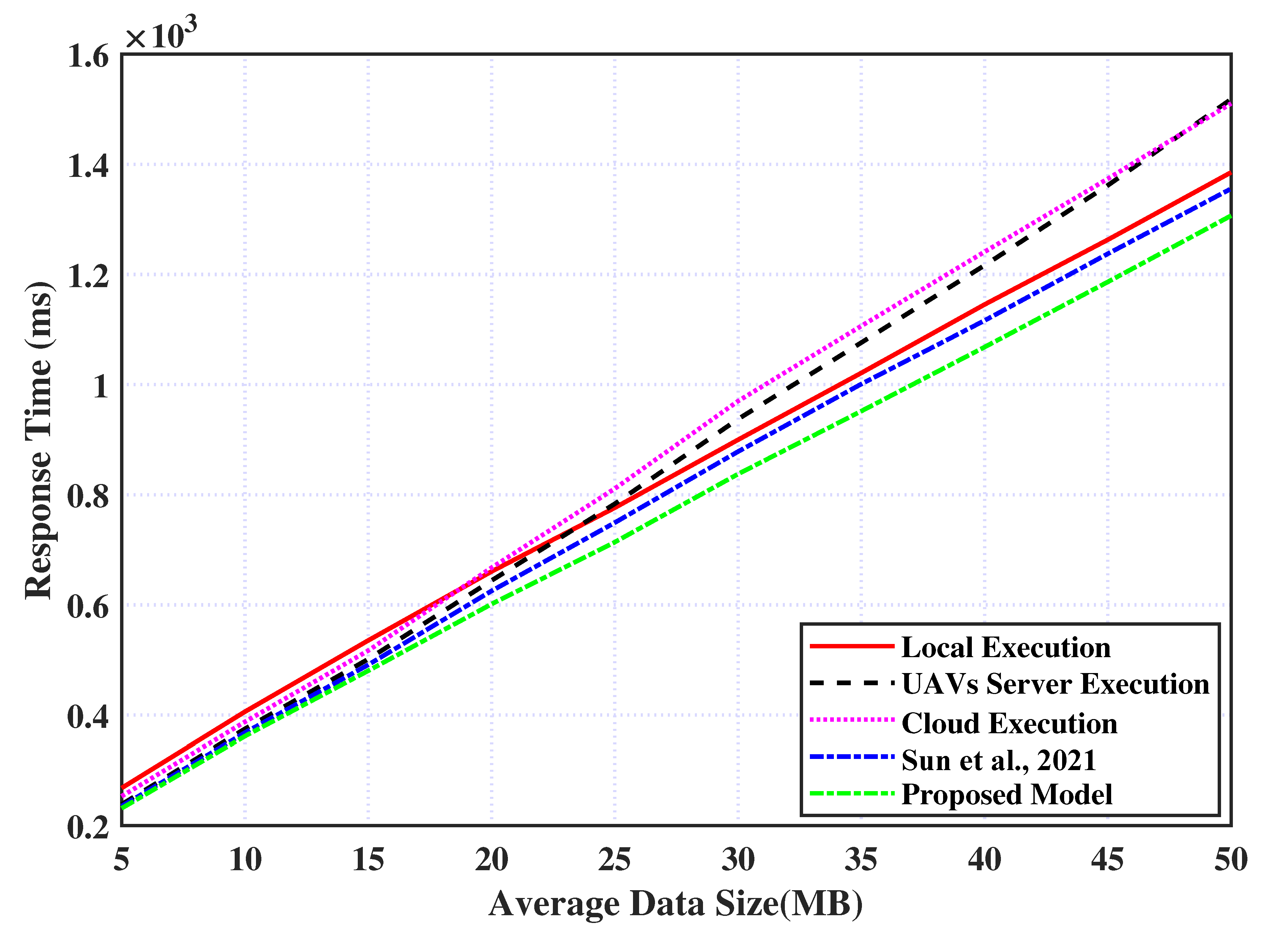
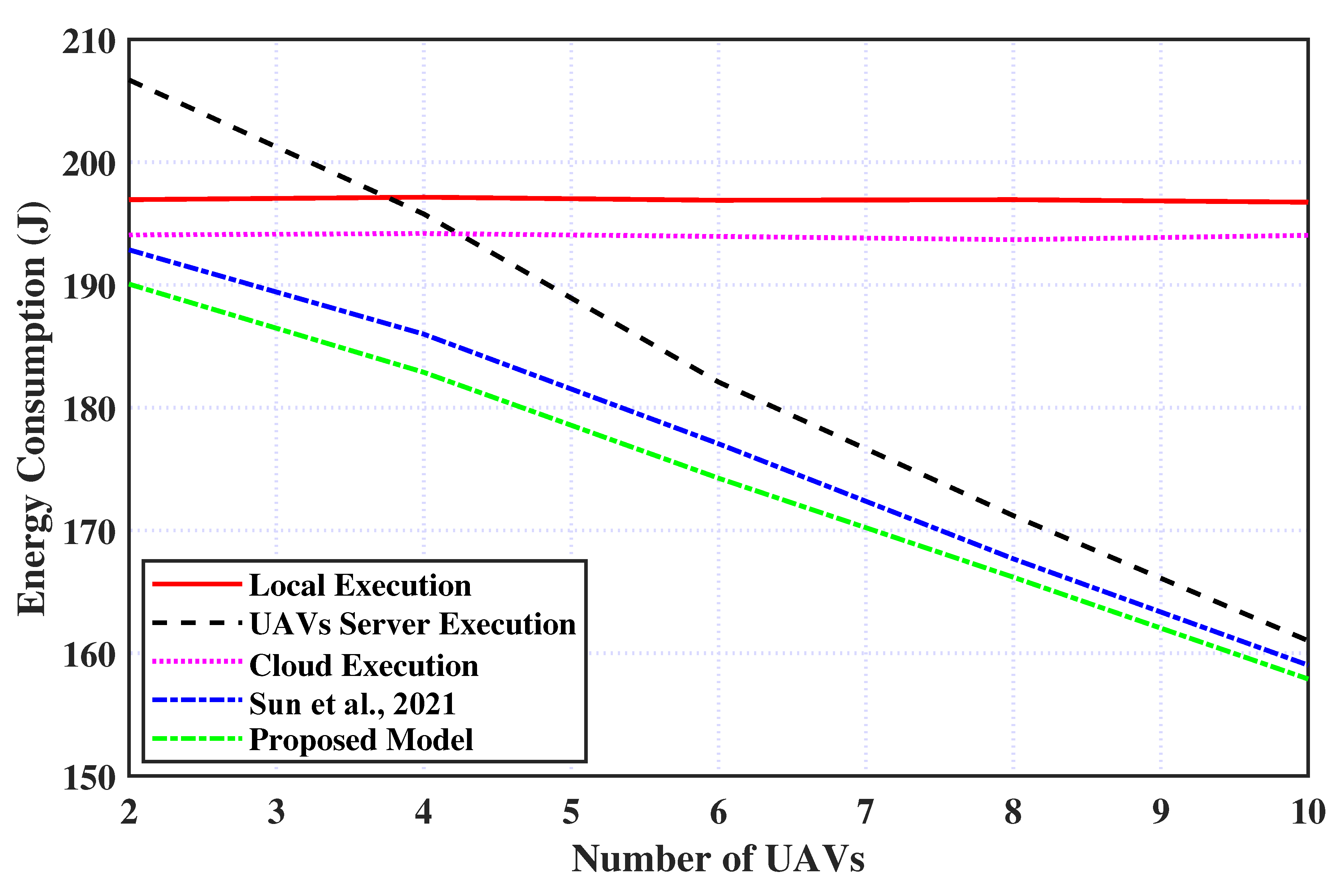
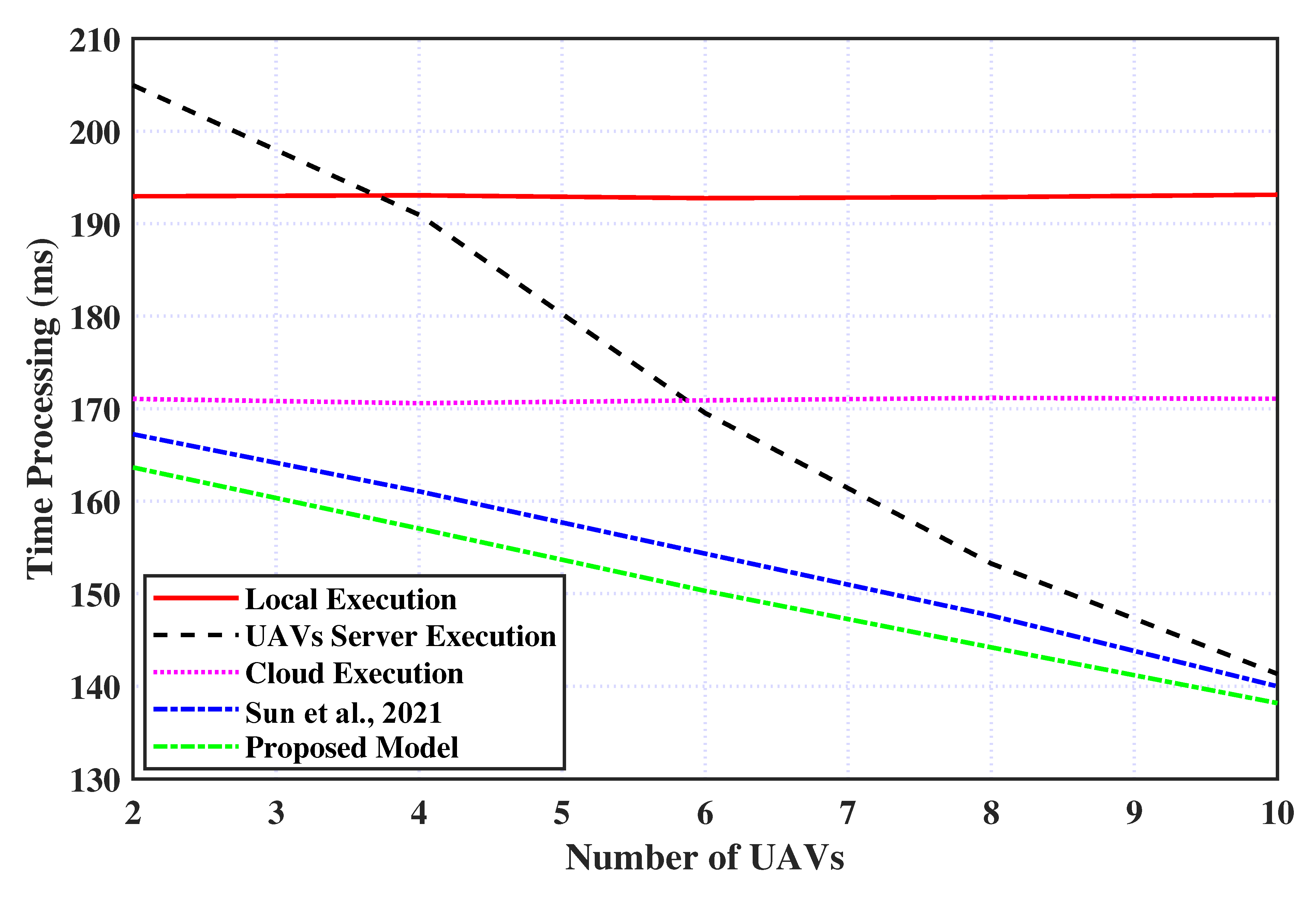
| Reference | Objective | Proposed Solution | User | UAV Server | Remote Cloud | Evaluation Methods | Weakness | ||
|---|---|---|---|---|---|---|---|---|---|
| Single | Multiple | Single | Multiple | ||||||
| [20] | Minimize energy consumption | An energy-efficient framework for wireless-powered mobile cloud computing | ✓ | ✓ | ✓ | Simulation | Considering only one IoT user in the model is unrealistic. | ||
| [21] | Maximize weighted sum of computation rate | An online deep reinforcement learning framework for mobile edge computing | ✓ | ✓ | Numerical results, simulation | Execution time is not considered. | |||
| [25] | Minimize time and energy | An efficient algorithm based on deep meta reinforcement learning | ✓ | ✓ | ✓ | Simulation | Deadline for computation tasks is not considered | ||
| [26] | Optimize quality of experience | A new quality of experience model | ✓ | ✓ | Simulation | Resource cooperation is not considered. | |||
| [27] | Maximize energy efficiency under minimum quality of service constraint | An integrated model is proposed for task offloading and allocating resources | ✓ | ✓ | ✓ | Simulation | Private data protection and the resource cooperation are not addressed. | ||
| [22] | Minimize energy and execution latency | A partial task offloading model | ✓ | ✓ | Simulation | Deadline for computation tasks is not considered and considering only one IoT user in the model is unrealistic. | |||
| [23] | Reduce energy consumption | A multi-user with a multi-edge task offloading model | ✓ | ✓ | Simulation | Considering only one IoT user in the model is unrealistic. | |||
| [28] | An energy-efficient task offloading technique | ✓ | ✓ | Numerical results, simulation | Deadline for computation tasks and data privacy are not considered. | ||||
| [29] | Maximize system utility | A multi-server task offloading model | ✓ | ✓ | Simulation | Data privacy is not addressed. | |||
| [30] | Maximize system utility | A task offloading model for post-disaster rescue | ✓ | ✓ | Simulation | Data privacy is not addressed. | |||
| [19] | Minimize the overall energy consumption | An energy-efficient edge-cloud architecture for intelligent multi-UAV | ✓ | ✓ | ✓ | Simulation | Resource cooperation is not considered. | ||
| [24] | Minimize energy consumption | An energy-efficient collaborative task offloading model for cloud-enabled edge computing network | ✓ | ✓ | ✓ | Simulation | Data privacy is not addressed. | ||
| [31] | Minimize energy consumption | An air–ground integration technique for MEC | ✓ | ✓ | ✓ | Numerical results, simulation | Deadline for computation tasks and data privacy are not considered. | ||
| [32] | An edge-centric code offloading model | ✓ | ✓ | ✓ | Simulation | Data privacy is not addressed. | |||
| [33] | Minimize the energy consumption and execution time | A new weighted cost model for multi-UAV environment | ✓ | ✓ | ✓ | Simulation | Task execution’s deadline is not considered. | ||
| [34] | Minimize the processing delay of tasks | An intelligent task offloading model | ✓ | ✓ | ✓ | Numerical results, simulation | Execution time is not measured. | ||
| Our work | Minimize energy consumption with delay satisfaction | An efficient resource allocation and task offloading model | ✓ | ✓ | ✓ | Simulation | Mobility and security are not addressed. | ||
| Notation | Description |
|---|---|
| The set of small UAVs. | |
| The set of device users. | |
| i | The UAV. |
| j | The device user. |
| Size of data for task of mobile device j which is connected with UAV i. | |
| CPU cycles to accomplish the task of mobile device j which is connected with UAV i. | |
| Deadline requirement for task of mobile device j which is connected with UAV i. | |
| Offloading decision of mobile device. | |
| Uplink data rate for mobile device j which is connected with UAV i. | |
| System bandwidth of UAV i | |
| Transmission power of mobile device j which is connected with UAV i. | |
| Channel gain of UAV i | |
| Density of noise power of channel which is connected with UAV i | |
| Energy consumed per CPU cycle of mobile device j which is connected with UAV i. | |
| Propagation delay between UAV and cloud | |
| Computational capability of mobile device j which is connected with UAV i. | |
| CPU resource of UAV i assigned to mobile device j | |
| CPU resource of cloud assigned to mobile device j which is connected with UAV i. | |
| Time for local execution for the task of mobile device j which is connected with UAV i. | |
| Energy for local executing task of mobile device j which is connected with UAV i | |
| Time for transmitting task of mobile device j to UAV i. | |
| Time for executing task of mobile device j at UAV i. | |
| Time for executing task of mobile device j at Cloud server. |
| Parameter | Value |
|---|---|
| Number of UAVs | 5 |
| Number of mobile devices | 30 |
| Height of UAVs | 20 m |
| System bandwidth | 20 MHz |
| Transmission power | 0.1 Watt |
| Input data size | [0, 10] MB Unif-Dist |
| CPU cycles to accomplish task | 1000 cycles/bit |
| Computation capability of mobile device | |
| Energy consumption | J/cycle |
| UAVs server capability | [3.5, 5] Unif-Dist GHz |
| Cloud server capability | 20 GHz |
| Cloud propagation delay | 15 ms |
Publisher’s Note: MDPI stays neutral with regard to jurisdictional claims in published maps and institutional affiliations. |
© 2022 by the authors. Licensee MDPI, Basel, Switzerland. This article is an open access article distributed under the terms and conditions of the Creative Commons Attribution (CC BY) license (https://creativecommons.org/licenses/by/4.0/).
Share and Cite
Alhelaly, S.; Muthanna, A.; Elgendy, I.A. Optimizing Task Offloading Energy in Multi-User Multi-UAV-Enabled Mobile Edge-Cloud Computing Systems. Appl. Sci. 2022, 12, 6566. https://doi.org/10.3390/app12136566
Alhelaly S, Muthanna A, Elgendy IA. Optimizing Task Offloading Energy in Multi-User Multi-UAV-Enabled Mobile Edge-Cloud Computing Systems. Applied Sciences. 2022; 12(13):6566. https://doi.org/10.3390/app12136566
Chicago/Turabian StyleAlhelaly, Soha, Ammar Muthanna, and Ibrahim A. Elgendy. 2022. "Optimizing Task Offloading Energy in Multi-User Multi-UAV-Enabled Mobile Edge-Cloud Computing Systems" Applied Sciences 12, no. 13: 6566. https://doi.org/10.3390/app12136566
APA StyleAlhelaly, S., Muthanna, A., & Elgendy, I. A. (2022). Optimizing Task Offloading Energy in Multi-User Multi-UAV-Enabled Mobile Edge-Cloud Computing Systems. Applied Sciences, 12(13), 6566. https://doi.org/10.3390/app12136566








